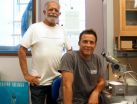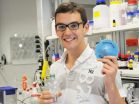(Press-News.org) The discovery of a new material combination that could lead to a more efficient approach to computer memory and logic will be described in the journal Nature on July 24, 2014. The research, led by Penn State University and Cornell University physicists, studies "spin torque" in devices that combine a standard magnetic material with a novel material known as a "topological insulator." The team's results show that such a scheme can be 10 times more efficient for controlling magnetic memory or logic than any other combination of materials measured to date.
"This is a really exciting development for the field because it is the first promising indication that we actually may be able to build a practical technology with these topological insulator materials, which many condensed-matter physicists have been studying with spintronics applications as the motivation," said co-principal-investigator Nitin Samarth, a professor of physics and the George A. and Margaret M. Downsbrough Department Head of Physics at Penn State. "Our experiment takes advantage of the very special surface of bismuth selenide -- a material that is a topological insulator -- which inherently supports the flow of electrons with an oriented spin," he said. "Our collaborators at Cornell found that, at normal room temperatures, we can use these spin-oriented electrons to very efficiently control the direction of the magnetic polarity in the adjacent material."
Professor Dan Ralph, the co-principal-investigator at Cornell University, said "Our team's research has overcome one of the key challenges to developing a spintronics technology based on spin-orbit coupling -- the efficiency with which an ordinary charge current can be converted into a spin current." The experiment used thin-film materials that were synthesized in Samarth's molecular-beam-epitaxy facility at Penn State by Graduate Student Joon Sue Lee and Research Associate Anthony Richardella. Graduate Student Alex Mellnik, in Ralph's laboratory at Cornell, fashioned these thin films into devices and carried out the spin-torque measurements. Professor Eun-ah Kim and her group at Cornell developed the theoretical interpretation of the experiments.
Earlier this year, Samarth's group also co-authored a manuscript in Nature Communications with Professor Zahid Hasan's group at Princeton University. In that experiment, a systematic series of ultrathin bismuth selenide films synthesized at Penn State were used by Hasan and Graduate Student Su-yang Xu of his lab to demonstrate how the spin orientation of surface electrons in a topological insulator could be manipulated at room temperature using quantum tunneling. "The rapid progress shown in this field at Penn State and at laboratories around the world indicates that 'topological spintronics' shows great promise of becoming an attractive offshoot of more traditional approaches to spintronics technology," Samarth said.
INFORMATION:
The collaborative research by Penn State, Cornell, and Princeton is supported by a grant from the Defense Advanced Research Projects Agency (DARPA). The Penn State research on topological insulators also is supported by the Office of Naval Research and through C-SPIN, one of six centers of STARnet, a Semiconductor Research Corporation program, sponsored by the Microelectronics Advanced Research Corporation (MARCO) and DARPA. The Cornell team also is supported by the US National Science Foundation's Materials Research Science and Engineering Centers program (MRSEC) program through the Cornell Center for Materials Research, by the Army Research Office, and by the Kavli Institute at Cornell.
CONTACTS
Nitin Samarth: nsamarth@psu.edu, 814-863-1089
Barbara Kennedy (PIO): science@psu.edu, 814-863-4682
IMAGES
High-resolution illustrations are online at http://science.psu.edu/news-and-events/2014-news/Samarth7-2014
IMAGE CAPTIONS (from top to bottom on the pre-embargo webpage )
(#1) The atomic layers of the topological insulator bismuth selenide are visibel in this high-resolution electron microscope image.
(#2) This illustration shows the crystal structure of the topological insulator bismuth selenide, Se-Bi-Se-Bi-Se, consisting of five atomic layers ("quinlayers") of alternating selenide (Se) and bismuth (Bi).
(#3) The geometry of the researech device that the research team used for measuring spin torque consists of a thin sandwich of a ferromagnetic metal (permalloy) on top of an 8-nm thin layer of a topological insulator (bismuth selenide). The scientists send a microwave frequency current through the device in the presence of an in-plane magnetic field, exciting the ferromagnet into precessional motion like a top.
(#4) The scientists explain that this diagram shows "the measurement of the spin torque experienced by the precessing magnetization, probed via the magnetic field dependence of a DC
voltage. The symmetric component measures the in-plane ("x component") spin torque generated by a spin current, while the antisymmetric component measures the perpendicular component."
MORE INFORMATION
For a narrative description provided by Professor Samarth that provides an historical perspective and research information in more technical terms, contact Barbara Kennedy at science@psu.edu or 814-863-4682.
For a narrative description provided by the principal investigator, which provides an historical perspective and research information in more technical terms, contact Barbara Kennedy at science@psu.edu or 814-863-4682.
The birth of topological spintronics
2014-07-23
ELSE PRESS RELEASES FROM THIS DATE:
Strategy proposed for preventing diseases of aging
2014-07-23
AUDIO:
Some researchers are proposing that changing how medical care is delivered could help prevent multiple chronic diseases and extend healthy lifespan. The idea, they argue, would be to target the...
Click here for more information.
Medicine focuses almost entirely on fighting chronic diseases in a piecemeal fashion as symptoms develop. Instead, more efforts should be directed to promoting interventions that have the potential to prevent multiple chronic diseases and extend ...
Sleep deprivation may increase susceptibility to false memories
2014-07-23
Not getting enough sleep may increase the likelihood of forming false memories, according to research published in Psychological Science, a journal of the Association for Psychological Science.
In a study conducted by psychological scientist Steven J. Frenda of the University of California, Irvine and colleagues, sleep-deprived people who viewed photographs of a crime being committed and then read false information about the photos were more likely to report remembering the false details in the photos than were those who got a full night's sleep.
Research has demonstrated ...
Satellite shows Atlantic Tropical Depression degenerate
2014-07-23
NOAA's GOES-East satellite captured imagery of the Atlantic Ocean's Tropical Depression 2 is it degenerated into a tropical wave on July 23.
At 1445 UTC (10:45 a.m. EDT), NOAA's GOES-East satellite captured an image of what was once Tropical Depression 2 (TD2), about 400 miles east of the Lesser Antilles. The GOES-East visible satellite imagery indicated that the depression weakened since July 22. TD2 appeared as just a weak swirl of clouds with no strong thunderstorms or deep convection. The GOES image was created by NASA/NOAA's GOES Project at NASA's Goddard Space Flight ...
Gene inhibitor, salmon fibrin restore function lost in spinal cord injury
2014-07-23
Irvine, Calif., July 23, 2014 — A therapy combining salmon fibrin injections into the spinal cord and injections of a gene inhibitor into the brain restored voluntary motor function impaired by spinal cord injury, scientists at UC Irvine's Reeve-Irvine Research Center have found.
In a study on rodents, Gail Lewandowski and Oswald Steward achieved this breakthrough by turning back the developmental clock in a molecular pathway critical to the formation of corticospinal tract nerve connections and providing a scaffold so that neuronal axons at the injury site could grow ...
Fires in the Northern Territories July 2014
2014-07-23
Environment Canada has issued a high health risk warning for Yellowknife and surrounding area because of heavy smoke in the region due to forest fires. In the image taken by the Aqua satellite, the smoke is drifting eastward along normal wind patterns. Fire is an obvious health hazard, but the smoke that comes from fires is not quite so obvious and its effects are insidious.
The smoke released by any type of fire (forest, brush, crop, structure, tires, waste or wood burning) is a mixture of particles and chemicals produced by incomplete burning of carbon-containing ...
Study links enzyme to autistic behaviors
2014-07-23
RIVERSIDE, Calif. — Fragile X syndrome (FXS) is a genetic disorder that causes obsessive-compulsive and repetitive behaviors, and other behaviors on the autistic spectrum, as well as cognitive deficits. It is the most common inherited cause of mental impairment and the most common cause of autism.
Now biomedical scientists at the University of California, Riverside have published a study that sheds light on the cause of autistic behaviors in FXS. Appearing online today (July 23) in the Journal of Neuroscience, and highlighted also on the cover in this week's print issue ...
This week from AGU: New Oso report, rockfall in Yosemite, and earthquake models
2014-07-23
From AGU's blogs: Oso disaster had its roots in earlier landslides
A research team tasked with being some of the first scientists and engineers to evaluate extreme events has issued its findings on disastrous Oso, Washington, landslide. The report studies the conditions and causes related to the March 22 mudslide that killed 43 people and destroyed the Steelhead Haven neighborhood in Oso, Washington. The team from the Geotechnical Extreme Events Reconnaissance (GEER) Association, funded by the National Science Foundation, determined that intense rainfall in the three ...
York University researchers use bird 'backpacks' to put wood thrushes migration on the map
2014-07-23
TORONTO, July 23, 2014 – Migratory songbirds are disappearing, and though conservationists are examining several possible reasons such as climate change, loss of habitat, acid rain and light pollution, a key piece of the puzzle has remained missing: where do these birds go once they leave their breeding sites, and what threats may they be encountering along the way?
To answer this question, a team of researchers out of York University have created the first ever migratory connectivity map produced for a songbird, using tracking from both breeding and winter sites. They ...
Diseases of another kind
2014-07-23
The drought that has the entire country in its grip is affecting more than the color of people's lawns. It may also be responsible for the proliferation of a heat-loving amoeba commonly found in warm freshwater bodies, such as lakes, rivers and hot springs, which the drought has made warmer than usual this year.
A 9-year-old Kansas girl recently died of an infection caused by this parasite after swimming in several area lakes. The amoeba enters the body through the nose of an individual and travels to the brain. Nose plugs can lower the odds of this rare but fatal pathogen ...
ETH student develops filter for clean water around the world
2014-07-23
Roughly 780 million people around the world have no access to clean drinking water. According to the World Health Organization (WHO), 3.4 million people die from water-related diseases every year. ETH student Jeremy Nussbaumer set himself the goal of making a contribution to solving this problem. Working with researchers from a group led by Wendelin Stark, head of the Functional Materials Laboratory, the 23-year-old spent a year researching a membrane filter and developing a prototype.
"What makes our DrinkPure filter unique is that you can screw it on to virtually any ...









